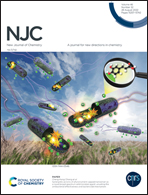Theoretical studies on boron dimesityl-based thermally activated delayed fluorescence organic emitters: excited-state properties and mechanisms†
Abstract
Herein, we investigated the luminescence mechanism of thermally activated delayed fluorescence (TADF) of blue-emitting methoxy-carbazole (Cz) substituted and boron dimesityl (BM)-based compounds (CzBM-1, -2, and -3) in cyclohexane using density functional theory (DFT), time-dependent DFT (TD-DFT) and DFT/multireference configuration interaction (DFT/MRCI) methods. On the basis of the optimized minimum-energy structures in the S0, S1, and T1 states, the results show that the lowest energy absorption and emission peaks originate from electronic transitions between the S0 and S1 states. These transitions are of charge-transfer characteristics because the HOMO and LUMO are located on the Cz and BM groups, respectively. The well spatial separation of the HOMO and LUMO contributes to a small energy difference (ΔEST) between S1 and T1, less than 0.13 eV, which promotes the reverse intersystem crossing (rISC) process from T1 to S1. At 300 K, the fluorescence emission and ISC rates are comparable (106–107 s−1), indicating that the excitons can deactivate by either emitting fluorescence or hopping to T1 through ISC. In contrast, the phosphorescence rate from T1 is negligible compared with the rISC rate (ca. 101 s−1vs. 105 s−1), which indicates that the phosphorescence emission channel is blocked, and only the up-conversion TADF emission is recorded. Importantly, krISC decreased sharply below 1.0 s−1 at 77 K, which indicates that the rISC process is sensitive to temperature and will be suppressed at low temperatures.



 Please wait while we load your content...
Please wait while we load your content...